Biophysical and Psychosocial Approaches for Dementia and Elderly Care
VerifiedAdded on 2023/06/03
|10
|2702
|283
AI Summary
This article discusses biophysical and psychosocial approaches for dementia and elderly care. It includes case studies, assessment tools, care priorities, and equity, rights, and access issues. The article is relevant for courses related to healthcare, gerontology, and social work. The content is available on Desklib, an online library for study material with solved assignments, essays, and dissertations for various courses and universities.
Contribute Materials
Your contribution can guide someone’s learning journey. Share your
documents today.

BIOPHYSICAL AND PSYCHOSOCIAL
APPROACHES 1
BIOPHYSICAL AND PSYCHOSOCIAL APPROACHES
Student’s Name
Course Name
Professor’s Name
University Name
City, State
Date
APPROACHES 1
BIOPHYSICAL AND PSYCHOSOCIAL APPROACHES
Student’s Name
Course Name
Professor’s Name
University Name
City, State
Date
Secure Best Marks with AI Grader
Need help grading? Try our AI Grader for instant feedback on your assignments.
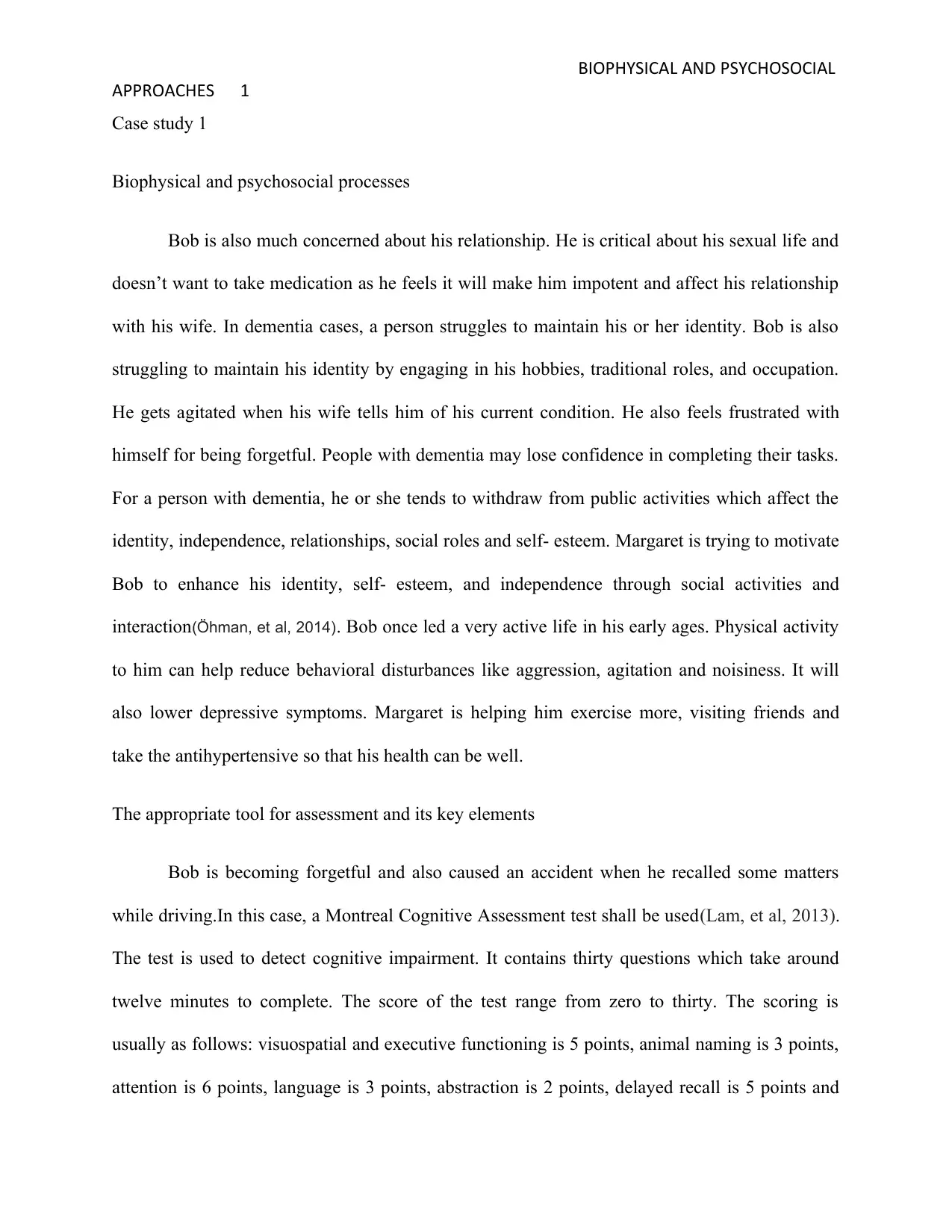
BIOPHYSICAL AND PSYCHOSOCIAL
APPROACHES 1
Case study 1
Biophysical and psychosocial processes
Bob is also much concerned about his relationship. He is critical about his sexual life and
doesn’t want to take medication as he feels it will make him impotent and affect his relationship
with his wife. In dementia cases, a person struggles to maintain his or her identity. Bob is also
struggling to maintain his identity by engaging in his hobbies, traditional roles, and occupation.
He gets agitated when his wife tells him of his current condition. He also feels frustrated with
himself for being forgetful. People with dementia may lose confidence in completing their tasks.
For a person with dementia, he or she tends to withdraw from public activities which affect the
identity, independence, relationships, social roles and self- esteem. Margaret is trying to motivate
Bob to enhance his identity, self- esteem, and independence through social activities and
interaction(Öhman, et al, 2014). Bob once led a very active life in his early ages. Physical activity
to him can help reduce behavioral disturbances like aggression, agitation and noisiness. It will
also lower depressive symptoms. Margaret is helping him exercise more, visiting friends and
take the antihypertensive so that his health can be well.
The appropriate tool for assessment and its key elements
Bob is becoming forgetful and also caused an accident when he recalled some matters
while driving.In this case, a Montreal Cognitive Assessment test shall be used(Lam, et al, 2013).
The test is used to detect cognitive impairment. It contains thirty questions which take around
twelve minutes to complete. The score of the test range from zero to thirty. The scoring is
usually as follows: visuospatial and executive functioning is 5 points, animal naming is 3 points,
attention is 6 points, language is 3 points, abstraction is 2 points, delayed recall is 5 points and
APPROACHES 1
Case study 1
Biophysical and psychosocial processes
Bob is also much concerned about his relationship. He is critical about his sexual life and
doesn’t want to take medication as he feels it will make him impotent and affect his relationship
with his wife. In dementia cases, a person struggles to maintain his or her identity. Bob is also
struggling to maintain his identity by engaging in his hobbies, traditional roles, and occupation.
He gets agitated when his wife tells him of his current condition. He also feels frustrated with
himself for being forgetful. People with dementia may lose confidence in completing their tasks.
For a person with dementia, he or she tends to withdraw from public activities which affect the
identity, independence, relationships, social roles and self- esteem. Margaret is trying to motivate
Bob to enhance his identity, self- esteem, and independence through social activities and
interaction(Öhman, et al, 2014). Bob once led a very active life in his early ages. Physical activity
to him can help reduce behavioral disturbances like aggression, agitation and noisiness. It will
also lower depressive symptoms. Margaret is helping him exercise more, visiting friends and
take the antihypertensive so that his health can be well.
The appropriate tool for assessment and its key elements
Bob is becoming forgetful and also caused an accident when he recalled some matters
while driving.In this case, a Montreal Cognitive Assessment test shall be used(Lam, et al, 2013).
The test is used to detect cognitive impairment. It contains thirty questions which take around
twelve minutes to complete. The score of the test range from zero to thirty. The scoring is
usually as follows: visuospatial and executive functioning is 5 points, animal naming is 3 points,
attention is 6 points, language is 3 points, abstraction is 2 points, delayed recall is 5 points and
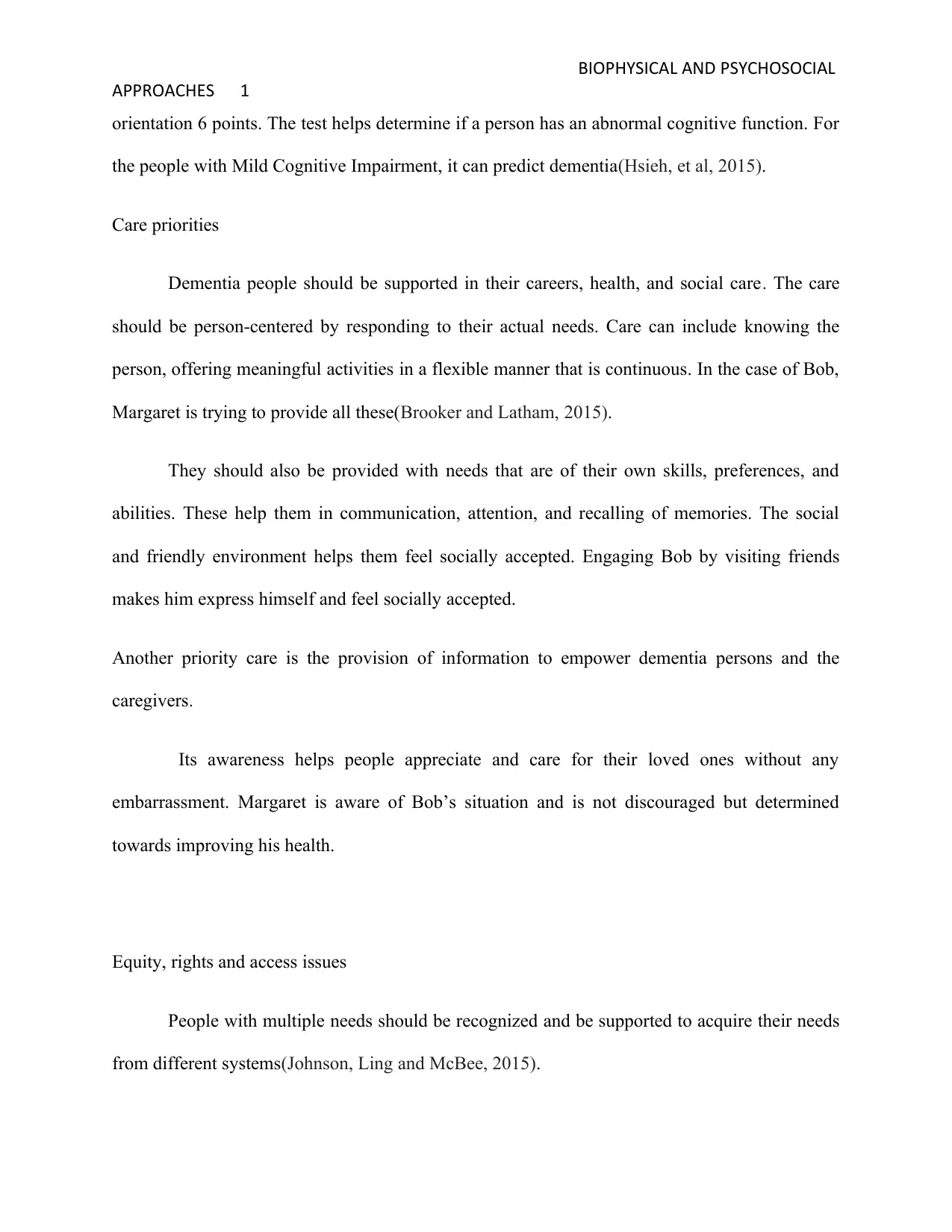
BIOPHYSICAL AND PSYCHOSOCIAL
APPROACHES 1
orientation 6 points. The test helps determine if a person has an abnormal cognitive function. For
the people with Mild Cognitive Impairment, it can predict dementia(Hsieh, et al, 2015).
Care priorities
Dementia people should be supported in their careers, health, and social care. The care
should be person-centered by responding to their actual needs. Care can include knowing the
person, offering meaningful activities in a flexible manner that is continuous. In the case of Bob,
Margaret is trying to provide all these(Brooker and Latham, 2015).
They should also be provided with needs that are of their own skills, preferences, and
abilities. These help them in communication, attention, and recalling of memories. The social
and friendly environment helps them feel socially accepted. Engaging Bob by visiting friends
makes him express himself and feel socially accepted.
Another priority care is the provision of information to empower dementia persons and the
caregivers.
Its awareness helps people appreciate and care for their loved ones without any
embarrassment. Margaret is aware of Bob’s situation and is not discouraged but determined
towards improving his health.
Equity, rights and access issues
People with multiple needs should be recognized and be supported to acquire their needs
from different systems(Johnson, Ling and McBee, 2015).
APPROACHES 1
orientation 6 points. The test helps determine if a person has an abnormal cognitive function. For
the people with Mild Cognitive Impairment, it can predict dementia(Hsieh, et al, 2015).
Care priorities
Dementia people should be supported in their careers, health, and social care. The care
should be person-centered by responding to their actual needs. Care can include knowing the
person, offering meaningful activities in a flexible manner that is continuous. In the case of Bob,
Margaret is trying to provide all these(Brooker and Latham, 2015).
They should also be provided with needs that are of their own skills, preferences, and
abilities. These help them in communication, attention, and recalling of memories. The social
and friendly environment helps them feel socially accepted. Engaging Bob by visiting friends
makes him express himself and feel socially accepted.
Another priority care is the provision of information to empower dementia persons and the
caregivers.
Its awareness helps people appreciate and care for their loved ones without any
embarrassment. Margaret is aware of Bob’s situation and is not discouraged but determined
towards improving his health.
Equity, rights and access issues
People with multiple needs should be recognized and be supported to acquire their needs
from different systems(Johnson, Ling and McBee, 2015).
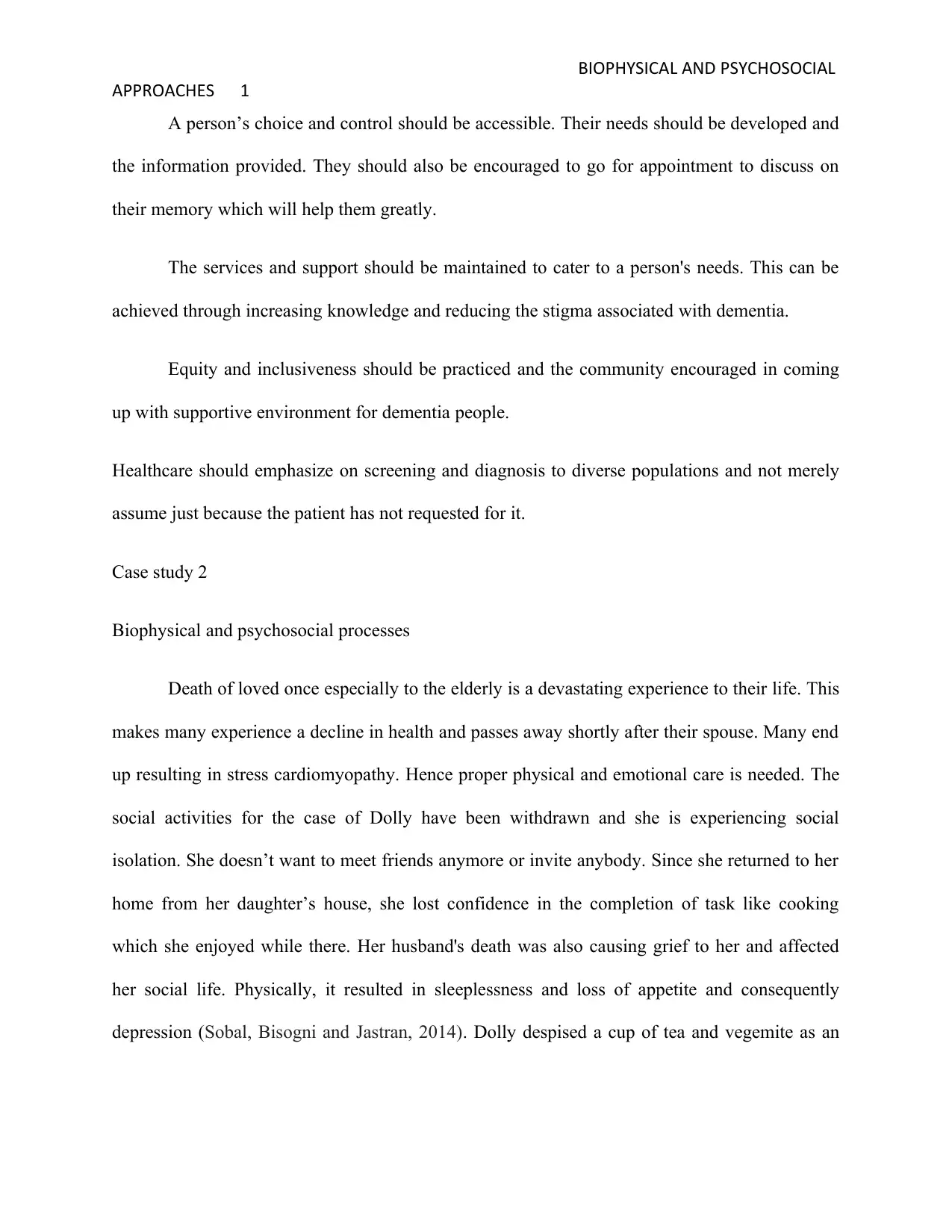
BIOPHYSICAL AND PSYCHOSOCIAL
APPROACHES 1
A person’s choice and control should be accessible. Their needs should be developed and
the information provided. They should also be encouraged to go for appointment to discuss on
their memory which will help them greatly.
The services and support should be maintained to cater to a person's needs. This can be
achieved through increasing knowledge and reducing the stigma associated with dementia.
Equity and inclusiveness should be practiced and the community encouraged in coming
up with supportive environment for dementia people.
Healthcare should emphasize on screening and diagnosis to diverse populations and not merely
assume just because the patient has not requested for it.
Case study 2
Biophysical and psychosocial processes
Death of loved once especially to the elderly is a devastating experience to their life. This
makes many experience a decline in health and passes away shortly after their spouse. Many end
up resulting in stress cardiomyopathy. Hence proper physical and emotional care is needed. The
social activities for the case of Dolly have been withdrawn and she is experiencing social
isolation. She doesn’t want to meet friends anymore or invite anybody. Since she returned to her
home from her daughter’s house, she lost confidence in the completion of task like cooking
which she enjoyed while there. Her husband's death was also causing grief to her and affected
her social life. Physically, it resulted in sleeplessness and loss of appetite and consequently
depression (Sobal, Bisogni and Jastran, 2014). Dolly despised a cup of tea and vegemite as an
APPROACHES 1
A person’s choice and control should be accessible. Their needs should be developed and
the information provided. They should also be encouraged to go for appointment to discuss on
their memory which will help them greatly.
The services and support should be maintained to cater to a person's needs. This can be
achieved through increasing knowledge and reducing the stigma associated with dementia.
Equity and inclusiveness should be practiced and the community encouraged in coming
up with supportive environment for dementia people.
Healthcare should emphasize on screening and diagnosis to diverse populations and not merely
assume just because the patient has not requested for it.
Case study 2
Biophysical and psychosocial processes
Death of loved once especially to the elderly is a devastating experience to their life. This
makes many experience a decline in health and passes away shortly after their spouse. Many end
up resulting in stress cardiomyopathy. Hence proper physical and emotional care is needed. The
social activities for the case of Dolly have been withdrawn and she is experiencing social
isolation. She doesn’t want to meet friends anymore or invite anybody. Since she returned to her
home from her daughter’s house, she lost confidence in the completion of task like cooking
which she enjoyed while there. Her husband's death was also causing grief to her and affected
her social life. Physically, it resulted in sleeplessness and loss of appetite and consequently
depression (Sobal, Bisogni and Jastran, 2014). Dolly despised a cup of tea and vegemite as an
Secure Best Marks with AI Grader
Need help grading? Try our AI Grader for instant feedback on your assignments.
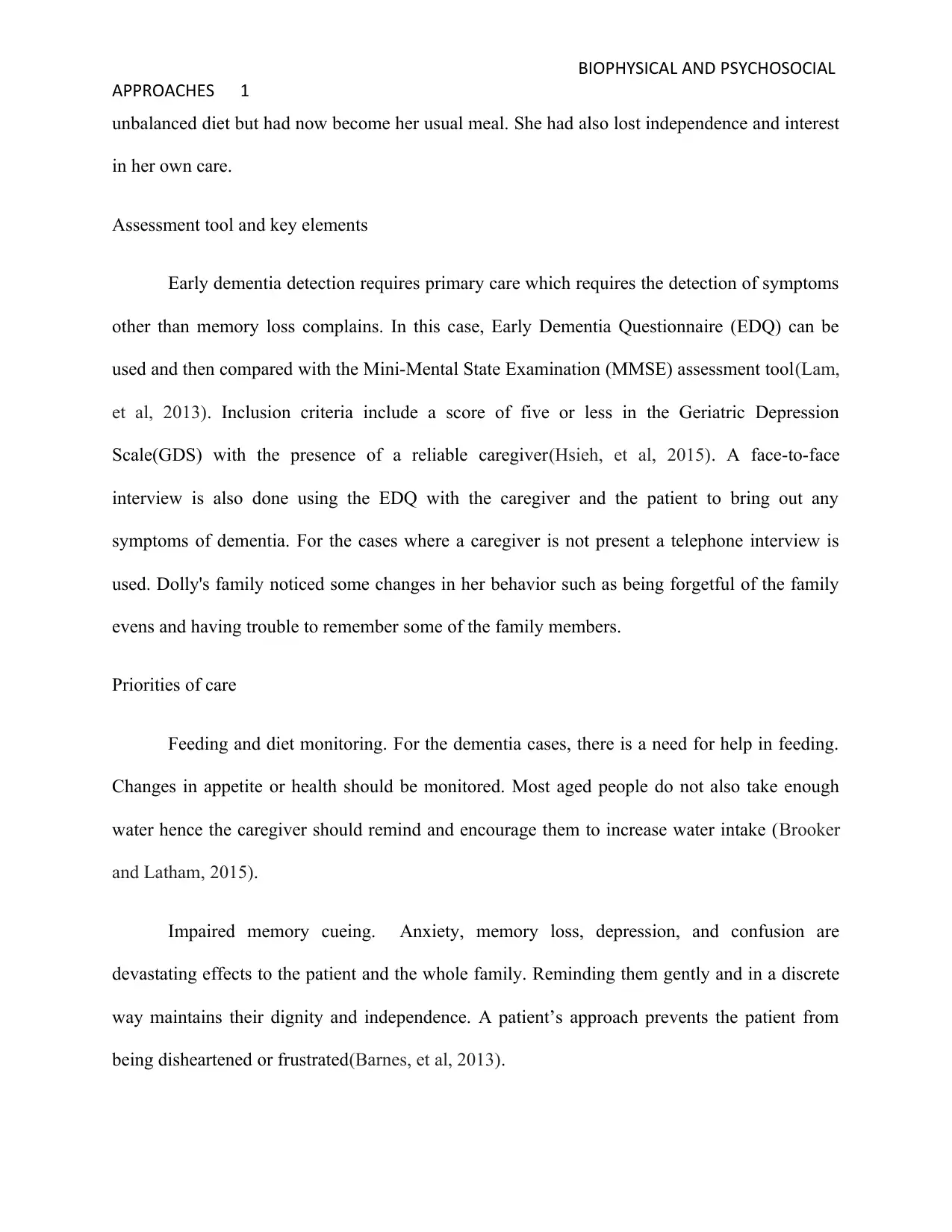
BIOPHYSICAL AND PSYCHOSOCIAL
APPROACHES 1
unbalanced diet but had now become her usual meal. She had also lost independence and interest
in her own care.
Assessment tool and key elements
Early dementia detection requires primary care which requires the detection of symptoms
other than memory loss complains. In this case, Early Dementia Questionnaire (EDQ) can be
used and then compared with the Mini-Mental State Examination (MMSE) assessment tool(Lam,
et al, 2013). Inclusion criteria include a score of five or less in the Geriatric Depression
Scale(GDS) with the presence of a reliable caregiver(Hsieh, et al, 2015). A face-to-face
interview is also done using the EDQ with the caregiver and the patient to bring out any
symptoms of dementia. For the cases where a caregiver is not present a telephone interview is
used. Dolly's family noticed some changes in her behavior such as being forgetful of the family
evens and having trouble to remember some of the family members.
Priorities of care
Feeding and diet monitoring. For the dementia cases, there is a need for help in feeding.
Changes in appetite or health should be monitored. Most aged people do not also take enough
water hence the caregiver should remind and encourage them to increase water intake (Brooker
and Latham, 2015).
Impaired memory cueing. Anxiety, memory loss, depression, and confusion are
devastating effects to the patient and the whole family. Reminding them gently and in a discrete
way maintains their dignity and independence. A patient’s approach prevents the patient from
being disheartened or frustrated(Barnes, et al, 2013).
APPROACHES 1
unbalanced diet but had now become her usual meal. She had also lost independence and interest
in her own care.
Assessment tool and key elements
Early dementia detection requires primary care which requires the detection of symptoms
other than memory loss complains. In this case, Early Dementia Questionnaire (EDQ) can be
used and then compared with the Mini-Mental State Examination (MMSE) assessment tool(Lam,
et al, 2013). Inclusion criteria include a score of five or less in the Geriatric Depression
Scale(GDS) with the presence of a reliable caregiver(Hsieh, et al, 2015). A face-to-face
interview is also done using the EDQ with the caregiver and the patient to bring out any
symptoms of dementia. For the cases where a caregiver is not present a telephone interview is
used. Dolly's family noticed some changes in her behavior such as being forgetful of the family
evens and having trouble to remember some of the family members.
Priorities of care
Feeding and diet monitoring. For the dementia cases, there is a need for help in feeding.
Changes in appetite or health should be monitored. Most aged people do not also take enough
water hence the caregiver should remind and encourage them to increase water intake (Brooker
and Latham, 2015).
Impaired memory cueing. Anxiety, memory loss, depression, and confusion are
devastating effects to the patient and the whole family. Reminding them gently and in a discrete
way maintains their dignity and independence. A patient’s approach prevents the patient from
being disheartened or frustrated(Barnes, et al, 2013).
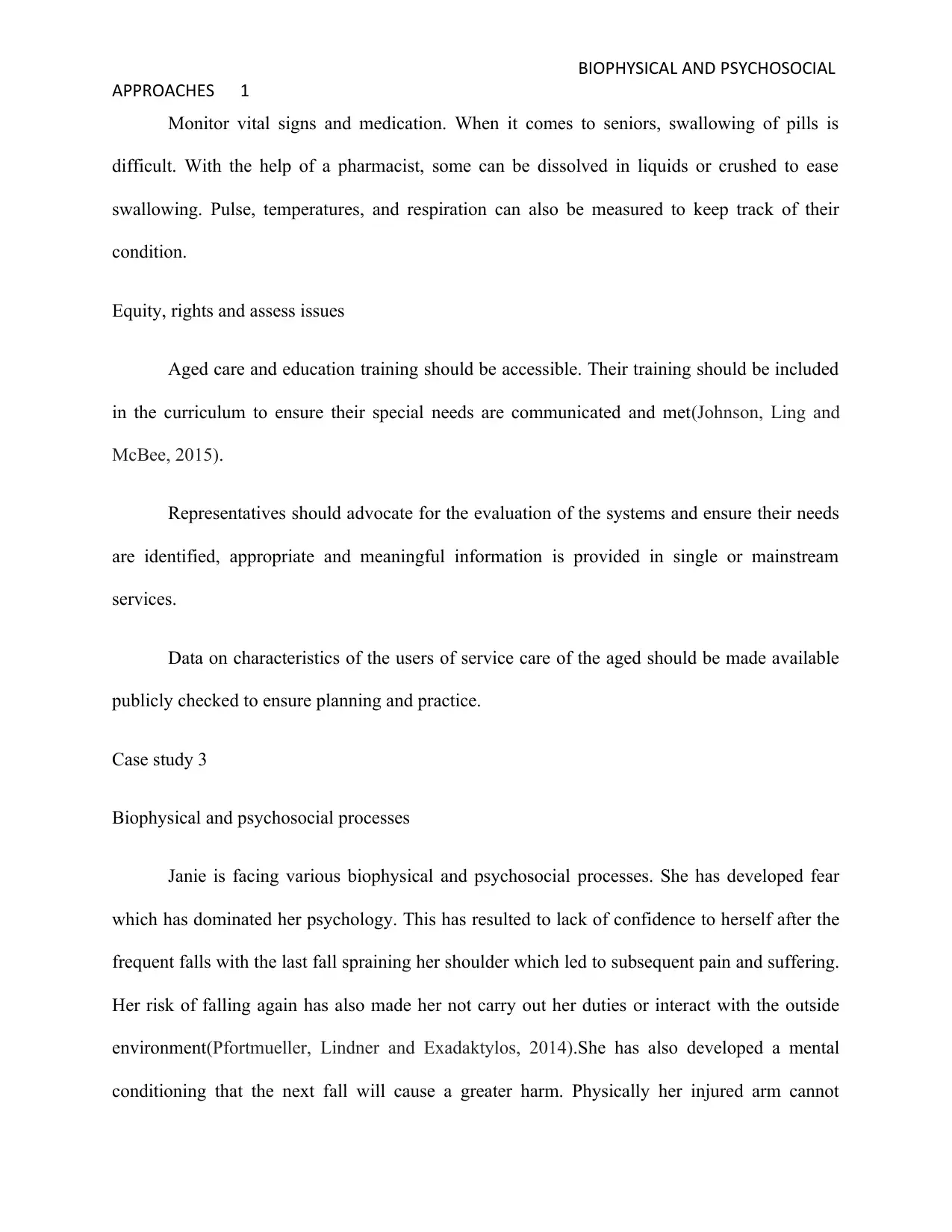
BIOPHYSICAL AND PSYCHOSOCIAL
APPROACHES 1
Monitor vital signs and medication. When it comes to seniors, swallowing of pills is
difficult. With the help of a pharmacist, some can be dissolved in liquids or crushed to ease
swallowing. Pulse, temperatures, and respiration can also be measured to keep track of their
condition.
Equity, rights and assess issues
Aged care and education training should be accessible. Their training should be included
in the curriculum to ensure their special needs are communicated and met(Johnson, Ling and
McBee, 2015).
Representatives should advocate for the evaluation of the systems and ensure their needs
are identified, appropriate and meaningful information is provided in single or mainstream
services.
Data on characteristics of the users of service care of the aged should be made available
publicly checked to ensure planning and practice.
Case study 3
Biophysical and psychosocial processes
Janie is facing various biophysical and psychosocial processes. She has developed fear
which has dominated her psychology. This has resulted to lack of confidence to herself after the
frequent falls with the last fall spraining her shoulder which led to subsequent pain and suffering.
Her risk of falling again has also made her not carry out her duties or interact with the outside
environment(Pfortmueller, Lindner and Exadaktylos, 2014).She has also developed a mental
conditioning that the next fall will cause a greater harm. Physically her injured arm cannot
APPROACHES 1
Monitor vital signs and medication. When it comes to seniors, swallowing of pills is
difficult. With the help of a pharmacist, some can be dissolved in liquids or crushed to ease
swallowing. Pulse, temperatures, and respiration can also be measured to keep track of their
condition.
Equity, rights and assess issues
Aged care and education training should be accessible. Their training should be included
in the curriculum to ensure their special needs are communicated and met(Johnson, Ling and
McBee, 2015).
Representatives should advocate for the evaluation of the systems and ensure their needs
are identified, appropriate and meaningful information is provided in single or mainstream
services.
Data on characteristics of the users of service care of the aged should be made available
publicly checked to ensure planning and practice.
Case study 3
Biophysical and psychosocial processes
Janie is facing various biophysical and psychosocial processes. She has developed fear
which has dominated her psychology. This has resulted to lack of confidence to herself after the
frequent falls with the last fall spraining her shoulder which led to subsequent pain and suffering.
Her risk of falling again has also made her not carry out her duties or interact with the outside
environment(Pfortmueller, Lindner and Exadaktylos, 2014).She has also developed a mental
conditioning that the next fall will cause a greater harm. Physically her injured arm cannot
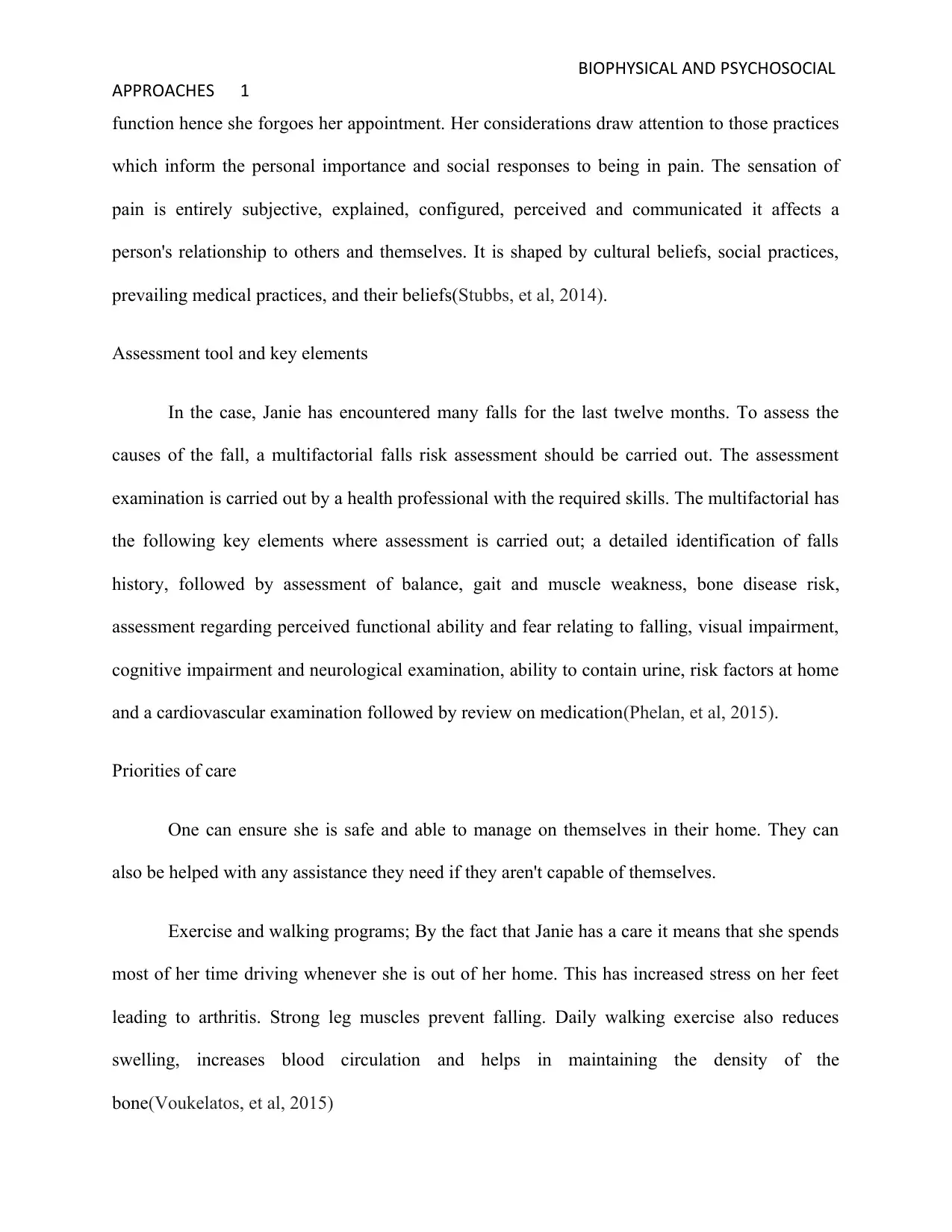
BIOPHYSICAL AND PSYCHOSOCIAL
APPROACHES 1
function hence she forgoes her appointment. Her considerations draw attention to those practices
which inform the personal importance and social responses to being in pain. The sensation of
pain is entirely subjective, explained, configured, perceived and communicated it affects a
person's relationship to others and themselves. It is shaped by cultural beliefs, social practices,
prevailing medical practices, and their beliefs(Stubbs, et al, 2014).
Assessment tool and key elements
In the case, Janie has encountered many falls for the last twelve months. To assess the
causes of the fall, a multifactorial falls risk assessment should be carried out. The assessment
examination is carried out by a health professional with the required skills. The multifactorial has
the following key elements where assessment is carried out; a detailed identification of falls
history, followed by assessment of balance, gait and muscle weakness, bone disease risk,
assessment regarding perceived functional ability and fear relating to falling, visual impairment,
cognitive impairment and neurological examination, ability to contain urine, risk factors at home
and a cardiovascular examination followed by review on medication(Phelan, et al, 2015).
Priorities of care
One can ensure she is safe and able to manage on themselves in their home. They can
also be helped with any assistance they need if they aren't capable of themselves.
Exercise and walking programs; By the fact that Janie has a care it means that she spends
most of her time driving whenever she is out of her home. This has increased stress on her feet
leading to arthritis. Strong leg muscles prevent falling. Daily walking exercise also reduces
swelling, increases blood circulation and helps in maintaining the density of the
bone(Voukelatos, et al, 2015)
APPROACHES 1
function hence she forgoes her appointment. Her considerations draw attention to those practices
which inform the personal importance and social responses to being in pain. The sensation of
pain is entirely subjective, explained, configured, perceived and communicated it affects a
person's relationship to others and themselves. It is shaped by cultural beliefs, social practices,
prevailing medical practices, and their beliefs(Stubbs, et al, 2014).
Assessment tool and key elements
In the case, Janie has encountered many falls for the last twelve months. To assess the
causes of the fall, a multifactorial falls risk assessment should be carried out. The assessment
examination is carried out by a health professional with the required skills. The multifactorial has
the following key elements where assessment is carried out; a detailed identification of falls
history, followed by assessment of balance, gait and muscle weakness, bone disease risk,
assessment regarding perceived functional ability and fear relating to falling, visual impairment,
cognitive impairment and neurological examination, ability to contain urine, risk factors at home
and a cardiovascular examination followed by review on medication(Phelan, et al, 2015).
Priorities of care
One can ensure she is safe and able to manage on themselves in their home. They can
also be helped with any assistance they need if they aren't capable of themselves.
Exercise and walking programs; By the fact that Janie has a care it means that she spends
most of her time driving whenever she is out of her home. This has increased stress on her feet
leading to arthritis. Strong leg muscles prevent falling. Daily walking exercise also reduces
swelling, increases blood circulation and helps in maintaining the density of the
bone(Voukelatos, et al, 2015)
Paraphrase This Document
Need a fresh take? Get an instant paraphrase of this document with our AI Paraphraser

BIOPHYSICAL AND PSYCHOSOCIAL
APPROACHES 1
Assistance in medical appointments; Caregivers should get the patient ready for
appointments either by car or taxi and help in giving the doctor the necessary information on
medication, medical history, and symptoms.
Physiotherapy; It is needed to help in gaining strength after an injury or surgery and also
strengthen muscles for balance. The caregiver can evaluate proper body ways and the need for a
walker, cane or other devices which can help reduce the risk of injury or fall again(Okubo,
Schoene and Lord, 2016).
Equity, rights and assess issues
Prosthetic devices have been developed to help improve postural balance in the elderly.
Vibrotactile device fit around the waist and give information regarding body tilt through
vibration. Also, there is a tongue- placed device which helps in providing information on the
head's position.
Professionals coming up with fall prevention programs should ensure the programs are
flexible to fit the different needs and preferences of the people involved. It should also add value
to them socially(Pfortmueller, Lindner and Exadaktylos, 2014).
Programs of fall prevention should ensurerelevant information is available in different
languages. Barriers like fear of falling, low self- efficacy should be addressed and activity
change encouraged to the participant(Vieira, Palmer and Chaves, 2016).
The professional involved in the assessment should consider discussing changes a
participant is willing to make in preventing falls.
APPROACHES 1
Assistance in medical appointments; Caregivers should get the patient ready for
appointments either by car or taxi and help in giving the doctor the necessary information on
medication, medical history, and symptoms.
Physiotherapy; It is needed to help in gaining strength after an injury or surgery and also
strengthen muscles for balance. The caregiver can evaluate proper body ways and the need for a
walker, cane or other devices which can help reduce the risk of injury or fall again(Okubo,
Schoene and Lord, 2016).
Equity, rights and assess issues
Prosthetic devices have been developed to help improve postural balance in the elderly.
Vibrotactile device fit around the waist and give information regarding body tilt through
vibration. Also, there is a tongue- placed device which helps in providing information on the
head's position.
Professionals coming up with fall prevention programs should ensure the programs are
flexible to fit the different needs and preferences of the people involved. It should also add value
to them socially(Pfortmueller, Lindner and Exadaktylos, 2014).
Programs of fall prevention should ensurerelevant information is available in different
languages. Barriers like fear of falling, low self- efficacy should be addressed and activity
change encouraged to the participant(Vieira, Palmer and Chaves, 2016).
The professional involved in the assessment should consider discussing changes a
participant is willing to make in preventing falls.
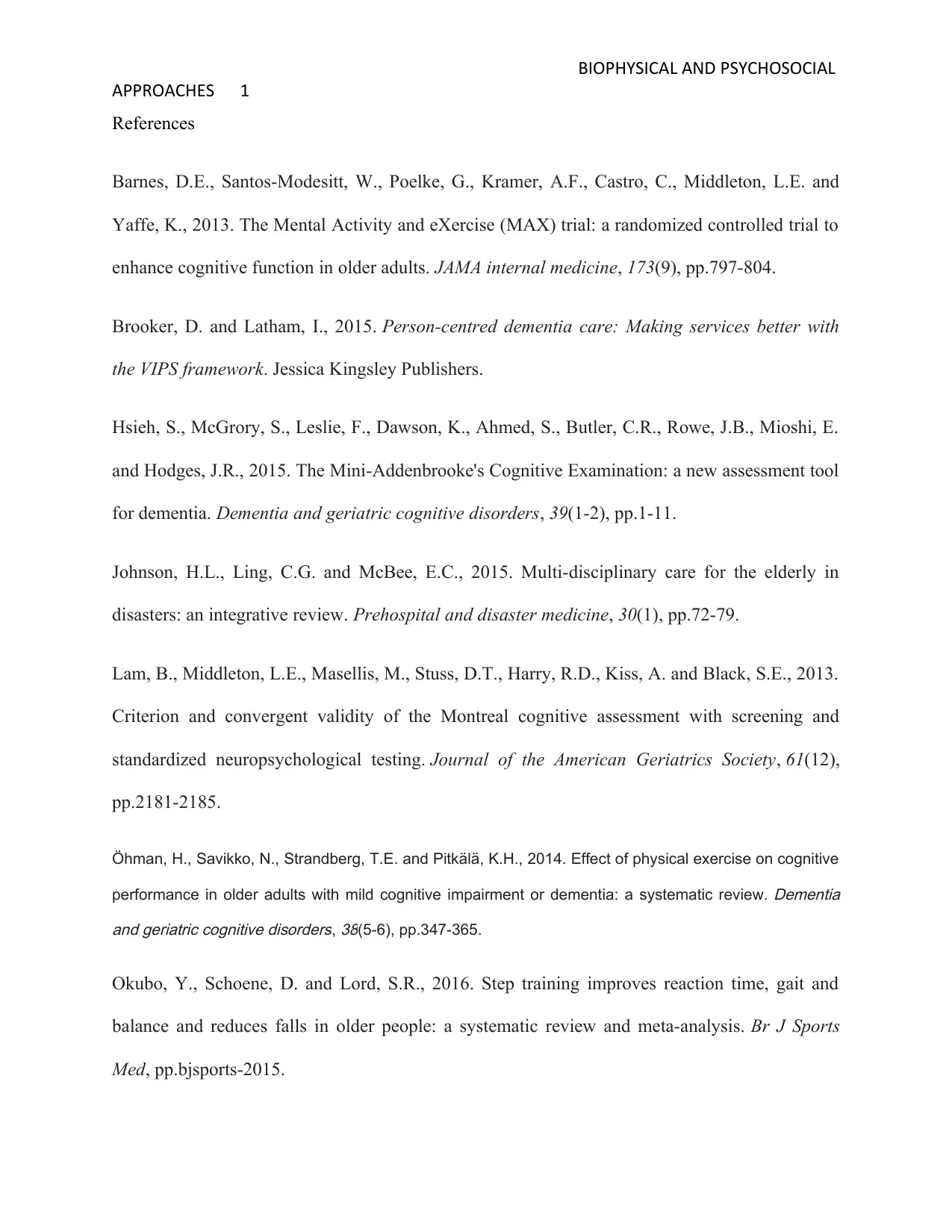
BIOPHYSICAL AND PSYCHOSOCIAL
APPROACHES 1
References
Barnes, D.E., Santos-Modesitt, W., Poelke, G., Kramer, A.F., Castro, C., Middleton, L.E. and
Yaffe, K., 2013. The Mental Activity and eXercise (MAX) trial: a randomized controlled trial to
enhance cognitive function in older adults. JAMA internal medicine, 173(9), pp.797-804.
Brooker, D. and Latham, I., 2015. Person-centred dementia care: Making services better with
the VIPS framework. Jessica Kingsley Publishers.
Hsieh, S., McGrory, S., Leslie, F., Dawson, K., Ahmed, S., Butler, C.R., Rowe, J.B., Mioshi, E.
and Hodges, J.R., 2015. The Mini-Addenbrooke's Cognitive Examination: a new assessment tool
for dementia. Dementia and geriatric cognitive disorders, 39(1-2), pp.1-11.
Johnson, H.L., Ling, C.G. and McBee, E.C., 2015. Multi-disciplinary care for the elderly in
disasters: an integrative review. Prehospital and disaster medicine, 30(1), pp.72-79.
Lam, B., Middleton, L.E., Masellis, M., Stuss, D.T., Harry, R.D., Kiss, A. and Black, S.E., 2013.
Criterion and convergent validity of the Montreal cognitive assessment with screening and
standardized neuropsychological testing. Journal of the American Geriatrics Society, 61(12),
pp.2181-2185.
Öhman, H., Savikko, N., Strandberg, T.E. and Pitkälä, K.H., 2014. Effect of physical exercise on cognitive
performance in older adults with mild cognitive impairment or dementia: a systematic review.
Dementia
and geriatric cognitive disorders,
38(5-6), pp.347-365.
Okubo, Y., Schoene, D. and Lord, S.R., 2016. Step training improves reaction time, gait and
balance and reduces falls in older people: a systematic review and meta-analysis. Br J Sports
Med, pp.bjsports-2015.
APPROACHES 1
References
Barnes, D.E., Santos-Modesitt, W., Poelke, G., Kramer, A.F., Castro, C., Middleton, L.E. and
Yaffe, K., 2013. The Mental Activity and eXercise (MAX) trial: a randomized controlled trial to
enhance cognitive function in older adults. JAMA internal medicine, 173(9), pp.797-804.
Brooker, D. and Latham, I., 2015. Person-centred dementia care: Making services better with
the VIPS framework. Jessica Kingsley Publishers.
Hsieh, S., McGrory, S., Leslie, F., Dawson, K., Ahmed, S., Butler, C.R., Rowe, J.B., Mioshi, E.
and Hodges, J.R., 2015. The Mini-Addenbrooke's Cognitive Examination: a new assessment tool
for dementia. Dementia and geriatric cognitive disorders, 39(1-2), pp.1-11.
Johnson, H.L., Ling, C.G. and McBee, E.C., 2015. Multi-disciplinary care for the elderly in
disasters: an integrative review. Prehospital and disaster medicine, 30(1), pp.72-79.
Lam, B., Middleton, L.E., Masellis, M., Stuss, D.T., Harry, R.D., Kiss, A. and Black, S.E., 2013.
Criterion and convergent validity of the Montreal cognitive assessment with screening and
standardized neuropsychological testing. Journal of the American Geriatrics Society, 61(12),
pp.2181-2185.
Öhman, H., Savikko, N., Strandberg, T.E. and Pitkälä, K.H., 2014. Effect of physical exercise on cognitive
performance in older adults with mild cognitive impairment or dementia: a systematic review.
Dementia
and geriatric cognitive disorders,
38(5-6), pp.347-365.
Okubo, Y., Schoene, D. and Lord, S.R., 2016. Step training improves reaction time, gait and
balance and reduces falls in older people: a systematic review and meta-analysis. Br J Sports
Med, pp.bjsports-2015.
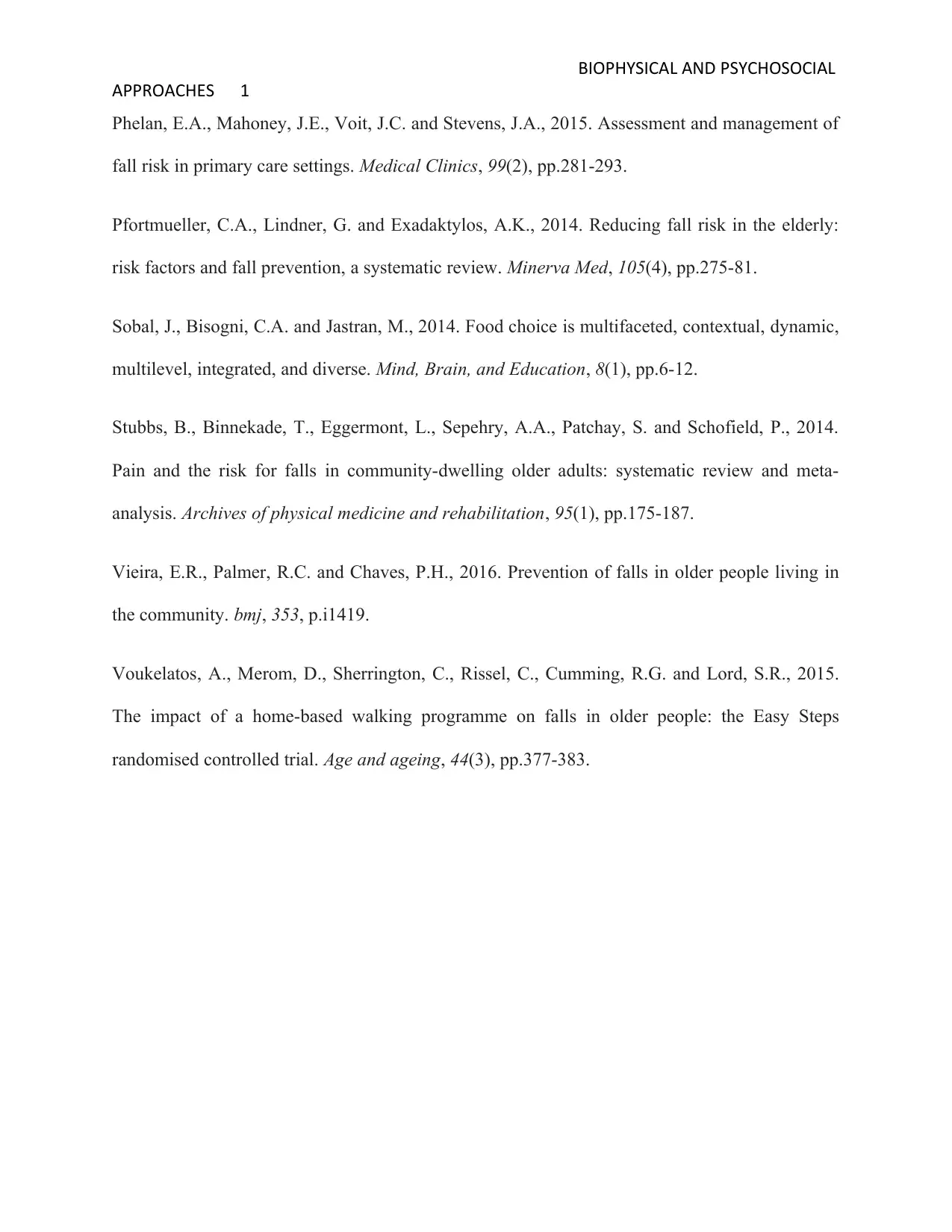
BIOPHYSICAL AND PSYCHOSOCIAL
APPROACHES 1
Phelan, E.A., Mahoney, J.E., Voit, J.C. and Stevens, J.A., 2015. Assessment and management of
fall risk in primary care settings. Medical Clinics, 99(2), pp.281-293.
Pfortmueller, C.A., Lindner, G. and Exadaktylos, A.K., 2014. Reducing fall risk in the elderly:
risk factors and fall prevention, a systematic review. Minerva Med, 105(4), pp.275-81.
Sobal, J., Bisogni, C.A. and Jastran, M., 2014. Food choice is multifaceted, contextual, dynamic,
multilevel, integrated, and diverse. Mind, Brain, and Education, 8(1), pp.6-12.
Stubbs, B., Binnekade, T., Eggermont, L., Sepehry, A.A., Patchay, S. and Schofield, P., 2014.
Pain and the risk for falls in community-dwelling older adults: systematic review and meta-
analysis. Archives of physical medicine and rehabilitation, 95(1), pp.175-187.
Vieira, E.R., Palmer, R.C. and Chaves, P.H., 2016. Prevention of falls in older people living in
the community. bmj, 353, p.i1419.
Voukelatos, A., Merom, D., Sherrington, C., Rissel, C., Cumming, R.G. and Lord, S.R., 2015.
The impact of a home-based walking programme on falls in older people: the Easy Steps
randomised controlled trial. Age and ageing, 44(3), pp.377-383.
APPROACHES 1
Phelan, E.A., Mahoney, J.E., Voit, J.C. and Stevens, J.A., 2015. Assessment and management of
fall risk in primary care settings. Medical Clinics, 99(2), pp.281-293.
Pfortmueller, C.A., Lindner, G. and Exadaktylos, A.K., 2014. Reducing fall risk in the elderly:
risk factors and fall prevention, a systematic review. Minerva Med, 105(4), pp.275-81.
Sobal, J., Bisogni, C.A. and Jastran, M., 2014. Food choice is multifaceted, contextual, dynamic,
multilevel, integrated, and diverse. Mind, Brain, and Education, 8(1), pp.6-12.
Stubbs, B., Binnekade, T., Eggermont, L., Sepehry, A.A., Patchay, S. and Schofield, P., 2014.
Pain and the risk for falls in community-dwelling older adults: systematic review and meta-
analysis. Archives of physical medicine and rehabilitation, 95(1), pp.175-187.
Vieira, E.R., Palmer, R.C. and Chaves, P.H., 2016. Prevention of falls in older people living in
the community. bmj, 353, p.i1419.
Voukelatos, A., Merom, D., Sherrington, C., Rissel, C., Cumming, R.G. and Lord, S.R., 2015.
The impact of a home-based walking programme on falls in older people: the Easy Steps
randomised controlled trial. Age and ageing, 44(3), pp.377-383.
1 out of 10
Related Documents
Your All-in-One AI-Powered Toolkit for Academic Success.
+13062052269
info@desklib.com
Available 24*7 on WhatsApp / Email
![[object Object]](/_next/static/media/star-bottom.7253800d.svg)
Unlock your academic potential
© 2024 | Zucol Services PVT LTD | All rights reserved.




